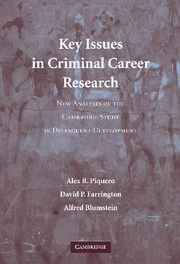 Key Issues in Criminal Career Research
Key Issues in Criminal Career Research Book contents
- Frontmatter
- Contents
- Foreword by Charles F. Wellford
- Acknowledgments
- 1 Introduction
- 2 Overview of Criminal Careers
- 3 Overview of CSDD Data
- 4 How Do Prevalence and Individual Offending Frequency Vary with Age?
- 5 How Does Onset Age Relate to Individual Offending Frequency?
- 6 How Does Specialization/Versatility Vary with Age?
- 7 Comparing the Validity of Prospective, Retrospective, and Official Onset for Different Offending Categories
- 8 What Is the Role of Co-offenders, and How Does It Vary with Age?
- 9 Are Chronic Offenders Serious Offenders, and Does This Relationship Vary with Age?
- 10 Trajectories of Offending
- 11 Developing Estimates of Duration and Residual Career Length
- 12 A Summary and an Agenda for Future Research
- References
- Index
- Titles in the series
4 - How Do Prevalence and Individual Offending Frequency Vary with Age?
Published online by Cambridge University Press: 30 July 2009
- Frontmatter
- Contents
- Foreword by Charles F. Wellford
- Acknowledgments
- 1 Introduction
- 2 Overview of Criminal Careers
- 3 Overview of CSDD Data
- 4 How Do Prevalence and Individual Offending Frequency Vary with Age?
- 5 How Does Onset Age Relate to Individual Offending Frequency?
- 6 How Does Specialization/Versatility Vary with Age?
- 7 Comparing the Validity of Prospective, Retrospective, and Official Onset for Different Offending Categories
- 8 What Is the Role of Co-offenders, and How Does It Vary with Age?
- 9 Are Chronic Offenders Serious Offenders, and Does This Relationship Vary with Age?
- 10 Trajectories of Offending
- 11 Developing Estimates of Duration and Residual Career Length
- 12 A Summary and an Agenda for Future Research
- References
- Index
- Titles in the series
Summary
What does the longitudinal patterning of criminal activity over age look like? Such basic questions have been studied in the criminal career literature, sometimes resulting in different conclusions.
Prevalence provides a measure of how many individuals participate in a crime type in any period. The shape of the age-crime curve for prevalence is generally agreed upon by most criminologists as data typically provide similar conclusions regarding trends in shape (though self-report records sometimes show an earlier peak for some crime types and a later peak for others). Both official and self-report records suggest that the prevalence of offending increases to a peak in the teenage years, at about ages 15–19, and then declines in the 20s (Blumstein et al., 1986; Elliott et al., 1989; Farrington, 1986; Piquero et al., 2003; Wolfgang et al., 1987). Prevalence curves typically form the basis of many conclusions regarding the aggregate age/crime relationship.
On the other hand, estimates of individual offending frequency, though generally minimally studied, tend to vary considerably – often because the definition of individual offense frequency varies. Some researchers prefer to simply plot the number of offenses (frequency) engaged in by sample members over time or over a particular time period, while other researchers argue that individual offending frequency should be defined by the amount of crime engaged in over a particular time period among those offenders who are active (i.e., offending) during that time period.
The evidence on individual offending frequency is mixed.
- Type
- Chapter
- Information
- Key Issues in Criminal Career ResearchNew Analyses of the Cambridge Study in Delinquent Development, pp. 46 - 59Publisher: Cambridge University PressPrint publication year: 2007
